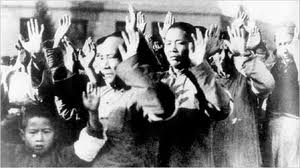The Awful Fate of Prisoners
- By Peter Harmsen
- 14 February, 2014
- 30 Comments
 Part of the Sino-Japanese struggle in the late 1930s was aimed at global public opinion, and movies were among the weapons. This short documentary, shot shortly after the fall of Shanghai in late 1937, is clearly painting the Japanese side in a positive light.
Part of the Sino-Japanese struggle in the late 1930s was aimed at global public opinion, and movies were among the weapons. This short documentary, shot shortly after the fall of Shanghai in late 1937, is clearly painting the Japanese side in a positive light.
It reports how “17 Japanese-appointed Chinese officials were murdered by terrorists over the last four months,” and goes on to explain how Chinese prisoners-of-war are made to clear up the mess they themselves created during months of war. “This power plant turbine,” the narrator says, “was wrecked by the very Chinese prisoners who are now forced to repair it.”
The documentary shows well-fed prisoners dressed in clean-looking identical uniforms. No Japanese guard is seen using any kind of force against the Chinese captives. Probably few believed it even at the time. Treatment of prisoners was notoriously dreadful, and foreign correspondents reported what they saw.
In fact, some of the prisoners shown on this footage may later have met a sinister fate. “Those captured Chinese who were not killed on the spot were compelled to do forced labor,” writes Japanese historian Hayashi Hirofumi in a paper. “Some of these were later killed, while others were let free. In all cases, however, their fate was arbitrarily decided by the troop concerned, with no consideration of international law.”
Of course, the worst maltreatment was hidden from view and only came to light in its full horror after the war. The use of live prisoners for bayonet practice is one such example.
A former Japanese soldier later reminisced how a Chinese POW had been tied to two poles so reinforcements recently arrived from Japan could be “bloodied”. The shivering young soldiers stabbing inexpertly at the defenseless man had a hard time finding his heart, and in the end the doomed Chinese started shouting at his killers: “Come on! Hurry up!”

 Copyright © 2024
Copyright © 2024
Leave a Reply